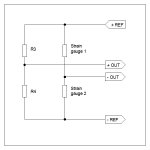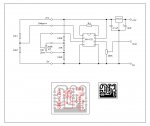Hello,
My name is Jim and I'm new to the pic axe(I have a 20M2). I got myself involved in a project for school using a Pic axe and am having some trouble understanding whats happening. My main goal is to make an auto bottle filling machine using two load cells. I have the load cells connected to a two stage op amp set up that is giving me around a 2 volt output w/o load...and goes up from there, but stays below 5v when at desired weight. Everything seems OK on the op amp side of things. The problem is when I put the Op amp output into the Pic. The extent of my program is to just Debug at this point to make sure the Pic is reading OK. When I do this the resolution displayed (and voltage read from Pic input) Is way higher then before I connected to pic...sometimes over 5v and maxes out the resolution at 255...and even when not maxed out to jumps around quite a bit...again I am new to this and somewhat new to electronics....one thought I was having was a problem with commons? But anyway I see it I am somehow getting voltage FROM somewhere when the pic is connected to op amp output. I guess what Im looking for is suggestion, or any insight anyone might have for this application. If I left out any inportant piece of info let me know and Ill try to answer.
My name is Jim and I'm new to the pic axe(I have a 20M2). I got myself involved in a project for school using a Pic axe and am having some trouble understanding whats happening. My main goal is to make an auto bottle filling machine using two load cells. I have the load cells connected to a two stage op amp set up that is giving me around a 2 volt output w/o load...and goes up from there, but stays below 5v when at desired weight. Everything seems OK on the op amp side of things. The problem is when I put the Op amp output into the Pic. The extent of my program is to just Debug at this point to make sure the Pic is reading OK. When I do this the resolution displayed (and voltage read from Pic input) Is way higher then before I connected to pic...sometimes over 5v and maxes out the resolution at 255...and even when not maxed out to jumps around quite a bit...again I am new to this and somewhat new to electronics....one thought I was having was a problem with commons? But anyway I see it I am somehow getting voltage FROM somewhere when the pic is connected to op amp output. I guess what Im looking for is suggestion, or any insight anyone might have for this application. If I left out any inportant piece of info let me know and Ill try to answer.


